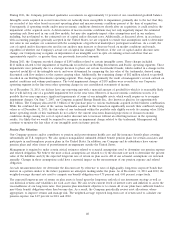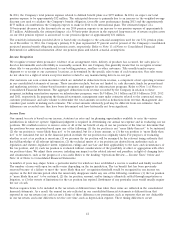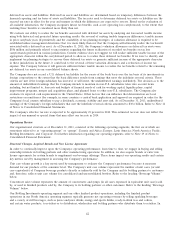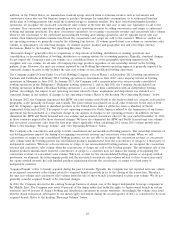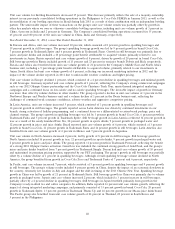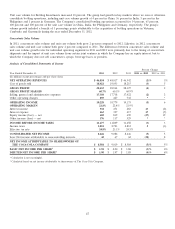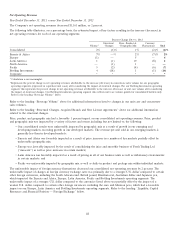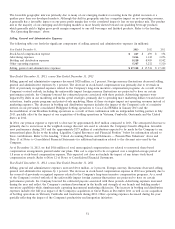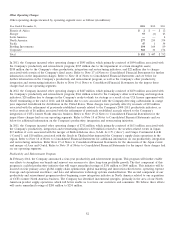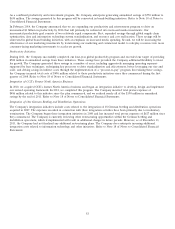Coca Cola 2013 Annual Report Download - page 46
Download and view the complete annual report
Please find page 46 of the 2013 Coca Cola annual report below. You can navigate through the pages in the report by either clicking on the pages listed below, or by using the keyword search tool below to find specific information within the annual report.
‘‘License agreements’’ refers to brands not owned by the Company, but for which we hold certain rights, generally including, but
not limited to, distribution rights, and from which we derive an economic benefit when these brands are ultimately sold. Typically,
the Company has not reported unit case volume or recognized concentrate sales volume related to these brands in periods prior
to the beginning of the term of the license agreement. Therefore, the unit case volume and concentrate sales volume from the
sale of these brands is incremental to prior year volume. We do not generally consider new license agreements to be structural
changes.
Beverage Volume
We measure the volume of Company beverage products sold in two ways: (1) unit cases of finished products and (2) concentrate
sales. As used in this report, ‘‘unit case’’ means a unit of measurement equal to 192 U.S. fluid ounces of finished beverage
(24 eight-ounce servings); and ‘‘unit case volume’’ means the number of unit cases (or unit case equivalents) of Company beverage
products directly or indirectly sold by the Company and its bottling partners to customers. Unit case volume primarily consists of
beverage products bearing Company trademarks. Also included in unit case volume are certain products licensed to, or distributed
by, our Company, and brands owned by Coca-Cola system bottlers for which our Company provides marketing support and from
the sale of which we derive economic benefit. In addition, unit case volume includes sales by joint ventures in which the Company
has an equity interest. We believe unit case volume is one of the measures of the underlying strength of the Coca-Cola system
because it measures trends at the consumer level. The unit case volume numbers used in this report are derived based on
estimates received by the Company from its bottling partners and distributors. Concentrate sales volume represents the amount of
concentrates and syrups (in all cases expressed in equivalent unit cases) sold by, or used in finished beverages sold by, the
Company to its bottling partners or other customers. Unit case volume and concentrate sales volume growth rates are not
necessarily equal during any given period. Factors such as seasonality, bottlers’ inventory practices, supply point changes, timing of
price increases, new product introductions and changes in product mix can impact unit case volume and concentrate sales volume
and can create differences between unit case volume and concentrate sales volume growth rates. In addition to the items
mentioned above, the impact of unit case volume from certain joint ventures in which the Company has an equity interest but to
which the Company does not sell concentrates or syrups may give rise to differences between unit case volume and concentrate
sales volume growth rates.
Information about our volume growth by operating segment is as follows:
Percent Change
2013 vs. 2012 2012 vs. 2011
Concentrate Concentrate
Year Ended December 31, Unit Cases1,2 Sales Unit Cases1,2 Sales
Worldwide 2% 2% 4% 4%
Eurasia & Africa 7% 7% 10% 9%
Europe (1) (1) (1) (2)
Latin America 1155
North America —— 22
Pacific 3575
Bottling Investments (17) N/A 10 N/A
1Bottling Investments operating segment data reflects unit case volume growth for consolidated bottlers only.
2Geographic segment data reflects unit case volume growth for all bottlers, both consolidated and unconsolidated, and distributors in the applicable
geographic areas.
Unit Case Volume
The Coca-Cola system sold 28.2 billion, 27.7 billion and 26.7 billion unit cases of our products in 2013, 2012 and 2011,
respectively. The number of unit cases sold in 2012 does not include BPW unit case volume for those countries in which BPW was
phased out during 2012, nor does it include unit case volume of products distributed in the United States under a sublicense from
a subsidiary of Nestl´
e which terminated at the end of 2012. In addition, the Company eliminated BPW and Nestl´
e licensed unit
case volume from the base year, where applicable, when calculating 2012 versus 2011 volume growth rates below. Refer to the
heading ‘‘Structural Changes, Acquired Brands and New License Agreements’’ above.
44








